Here’s all you need to know about what to look for when buying lobster, what types of lobster are available throughout the year, how to clean lobster, how to prepare lobster for cooking, all the different ways to cook lobster, and how to remove the cooked meat from the shell!
A comprehensive guide on how to cook lobster perfectly for lobster rolls or lobster risotto or any delectable lobster dish!
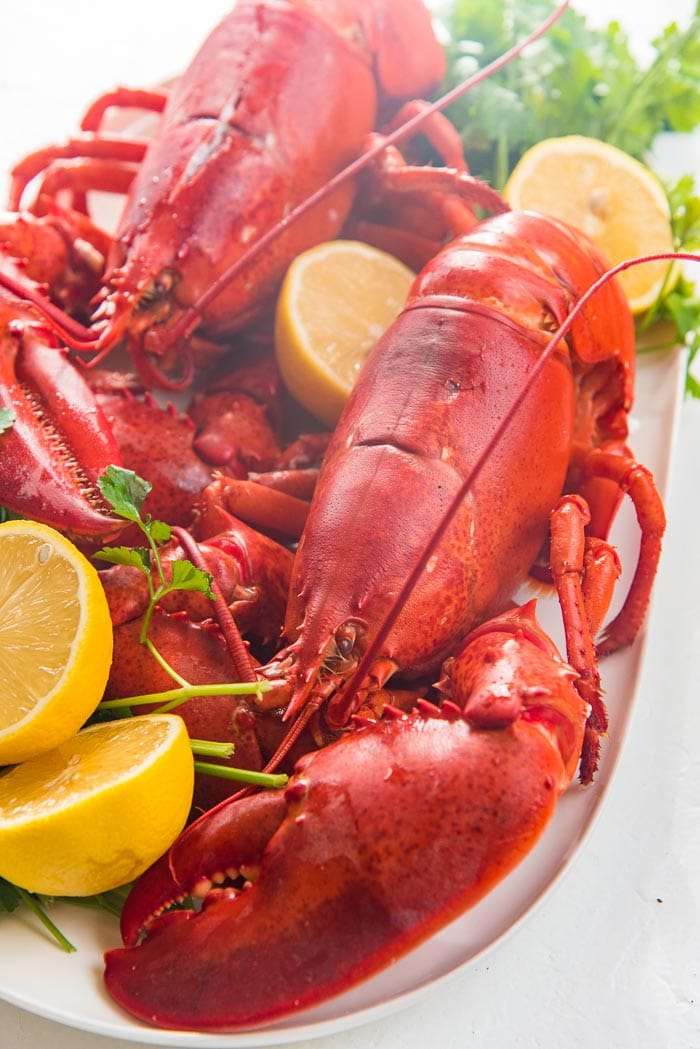
This guide covers everything from buying lobster, to how to clean and cook lobster, to even how to get lobster meat out of the shell!
Lobster is a lip-smackingly delicious delicacy, if done right (these Maine lobster rolls and butter lobster risotto are two of our absolute favorites!). And yes, it ain’t cheap.
Legend has it that a few centuries ago, lobster was knows as a poor man’s meal because they were so abundant, especially along the Massachusetts coastline. So abundant that people used lobster as fertilizer and to feed farm animals. Over time, they became less abundant and then fancy.
Lobster farming is also difficult business. They grow slowly, they’re vulnerable to disease, and need a lot to eat in order to grow. That makes them divas in the shellfish farming world, so it’s somewhat easier and more cost-effective to catch wild lobster. Having said that, lobster farming is increasing in popularity now too.
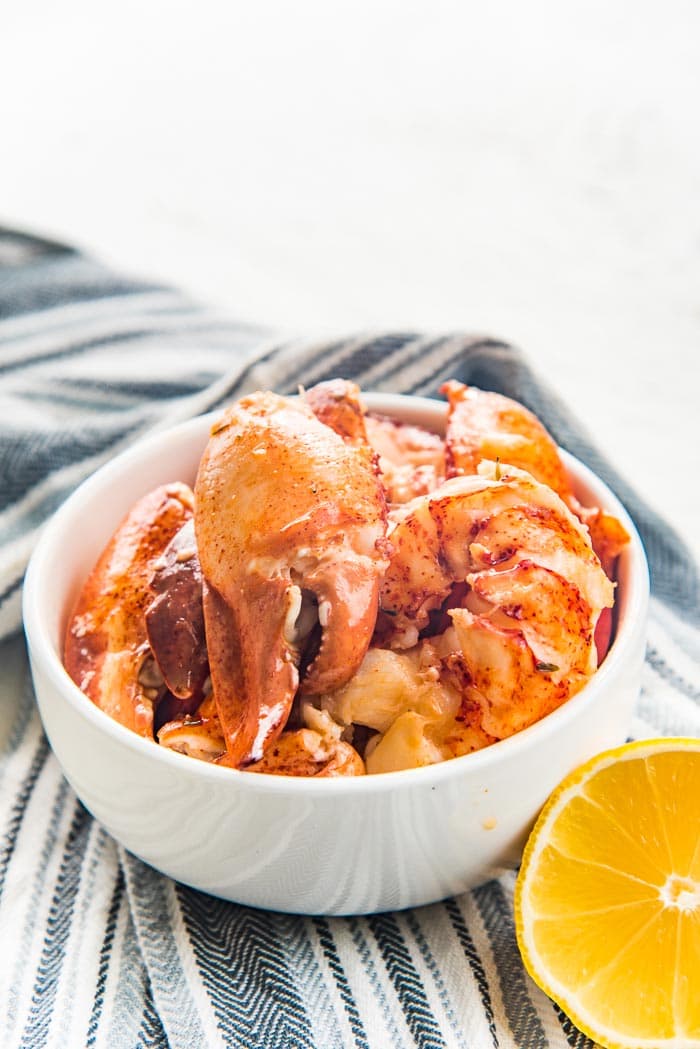
And since lobster is best eaten when freshly caught and killed, your proximity to the coast is important when it comes to having access to good, fresh lobster. Live lobster requires careful handling in order to be shipped over land, which again, is costly. Frozen lobster tail on the other hand is easier to ship, and easier to find, even in the middle of the country.
My first experience eating lobster was one to forget. We thought we ordered cooked lobster with melted butter, but a rubbery mess is what we got instead. The butter was yummy though.
My second experience, I remember more fondly. The lobster was buttery, flavorful and scrumptious. That set off my interest in learning how to cook lobster, and make sure it didn’t come out as rubber. I’ve cooked it plenty of times now, so today, I want to share ALL the techniques to cook lobster, including what I think is the BEST way.

How to choose lobster
In the US, the most popular kind of lobster is of course, Maine lobster. So here, I’ll share things to look for, when selecting Maine lobster, but this applies to ALL KINDS OF LOBSTER too!
- The most obvious tip of course is to make sure the lobster is alive and well. Look for lobster that’s lively, and not sluggish. If killed, the lobster must be eaten within (at most) 8 hours, if not immediately. Like crabs (like the blue swimmer crabs I use in my delicious spicy crab curry), when these crustaceans die, they release an enzyme that turns the flesh into mush.
- Make sure the lobsters haven’t been stored in a tank for a long time. Long-term, tank-resident lobsters get hungry and tend to shrink, so you’d end up with lobster that looks like a stud from the outside, with a hard shell, but has very little meat on the inside
- Another problem with starving lobsters is that they tend to eat each other – especially the antennae. So look for lobsters that have long antennae.
- Lobsters are usually blueish green color, but can also be brownish black or anything in between. They’ve got color pigments and chromatophores that give them different colors. However, all lobsters turn red as they cook. Not because they’re shy, but because of the way a carotenoid color pigment called astaxanthin in their shell reacts to heat. It’ll be a red brick color for hard-shell lobsters, and bright red for soft-shell lobsters.
- Maine lobsters are available all year round. Spring and summer are when lobsters “shed” and more soft shell lobsters become available. They are also more active then, and caught in abundance (and that’s when the market price for lobsters is also at its lowest). They are more sluggish in cooler/colder weather in the fall, winter and early spring, so they are harder to catch, and therefore more expensive. These will mostly be, Hard Shell Lobsters as they have hard shells when caught during this “off-season” period.
If you’re living in the middle of the country like I do, you can still get lobster shipped to you directly. Yes, it’s more costly, but the prices are pretty reasonable in the summer. Choose a company that will ship overnight, and will also guarantee a refund if the lobster arrives dead. That’s a good indication that you can trust them to deliver the good stuff to you.
Here are some online vendors that will deliver lobster to you.
- Maine Lobster Now – I order from here often. They have a money back guarantee, if your lobster arrives dead, and they have other fresh seafood options too.
- Lobster Anywhere
- Harbour Trading – Only have lobster available during season (spiny lobster). They are a seafood meal service, so they are more pricey, since they include ingredients for a whole meal.

What type of lobster is best?
You can choose between hard shell lobster and soft shell lobster depending on the time of year. Soft shell lobster can have relatively lower meat content. Soft shell lobsters are also sweeter than their brinier, hard shell counterpart. I’ve had both, and love both types, although I’d be lying if I didn’t admit that I love the taste of soft shell lobster a tad more.
How to cook lobster
Maine lobster, or any kind of lobster for that matter, can be cooked in four different ways.
- Boiling
- Steaming
- Grilling / BBQ / roasting
- Poaching
Before cooking lobster, it’s important to note that, lobsters don’t scream while being cooked! This is a very popular misconception, but that hiss you hear when they are being heated, is the escaping of air that’s trapped within these crustaceans. They don’t have vocal cords to scream. (That’ll be a good idea for a B-grade horror flick though!).
Also, most of the evidence points to the fact that lobsters do not and cannot process pain the same way we do. They don’t possess a complex nervous system or a “brain” as such, so outside of reflex reactions, they don’t respond to a pain stimulus the way animals with a more advanced biology do.
Having said that, I always take care to kill the lobster in a more “humane” way though. This is how we do it.
We use a very sharp knife, and then in one motion, quickly insert it just behind and between the eyes, and swiftly cut through the eyes.
Another way is to place the lobster in the freezer for about 10-20 minutes, before you kill them as mentioned above. Freezing numbs sensory reception of cold-blooded crustaceans like lobster, so you’re essentially putting them to sleep, before killing.
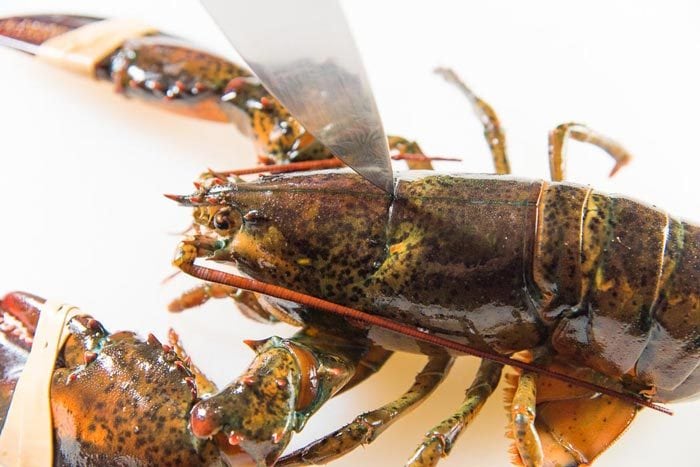
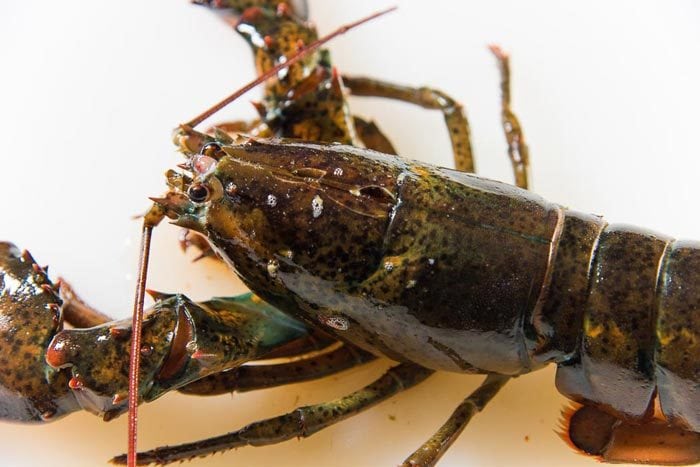
If you’re grilling or roasting lobster halves, then you will need to cut right through the lobster to separate the halves. You can use a sharp knife or even kitchen shears (to cut through the lobster tail shell) to do this. Then you will need to clean out the tomalley (green stuff), or roe (black stuff, if it’s a female lobster), found in the body cavity. Some people like to eat the tomalley, but unless you know for sure where the lobster was caught, then I highly recommend discarding it.
If you’re boiling or steaming lobster, you will definitely need a pot that’s large enough to fit the lobster. So if you’re cooking more than one lobster at a time, make sure they fit in the pot first.
The length of cooking time does NOT increase with the number of lobsters, however, it DOES change depending on whether you’re cooking soft shell lobster or hard shell lobster. Soft shell lobster cooks faster, so the cook time needs to be reduced by 2-3 minutes.
Now let’s look at each of these cooking methods separately.
How to boil lobster for even cooking
- Fill a pot with water – about 3/4 of the way. Remember all lobsters should be COMPLETELY submerged in the water.
- Add 2 – 4 tbsp of sea salt per gallon of water. This water will season the lobster too, so use more or less sea salt depending on how much you’d like to season the lobster.
- Bring the salted water to a boil. Then plunge your live lobsters (or immediately after killing them humanely) head first, into the water. Use gloves or tongs if necessary.
- Stir the pot halfway through to ensure even cooking. The lobsters will turn bright red when they are done.
- Plunge the cooked lobsters into an ice bath, OR cool water, or let it stand for a few minutes to cool down.
- Then the lobster meat can be removed from the shell, or the lobsters can be cut in half and served as is (along with lobster crackers for the claws), with some melted butter and herbs.
Lobster boiling times
| Lobster size | Boiling time |
| 1.0 lb | 6 – 7 minutes |
| 1.25 lb | 8 – 9 minutes |
| 1.5 lb | 10 minutes |
| 2.0 lb | 15 minutes |
| 2.5 lb | 20 minutes |
| 3.0 lb | 25 minutes |
How to steam lobster for faster cooking with more flavor
Make sure your pot is large enough when steaming lobster, so you don’t overcrowd it. Steaming is my preferred method of cooking lobster at home, because you lose less flavor this way. Plus, this method cooks the lobster faster.
Steam the lobster for 9 minutes for the 1st pound, then add 4 minutes for each additional pound. So 1 lb will cook for 9 minutes, 2 lbs for 13 minutes and so on.
- Fill a pot with about 2 inches of water. Add salt (generously, so it’s almost like sea water). Optionally, you can add sea weed to the water as well.
- Place a steaming rack in the pot, or you can place the live lobsters (or immediately after killing them humanely) in a steaming basket.
- Bring the water to a boil, with the lid closed.
- When the water comes to a boil, lower the lobsters into the pot. Close the lid and start the timer.
- The lobsters will turn bright red when they are cooked through.
- Remove the steamed lobsters and plunge them into an ice bath or cold water. Alternatively, let them cool down for a few minutes.
Did you know that you can cook ONE 1.5 lb lobster in a 6 qt inner pot of an Instant Pot, on the saute setting, with the steamed cooking method?
Lobster steaming times
| Lobster size | Steaming time |
| 1.0 lb | 9 minutes |
| 1.25 lb | 10 minutes |
| 1.5 lb | 11 minutes |
| 2.0 lb | 13 minutes |
| 2.5 lb | 15 minutes |
| 3.0 lb | 17 minutes |
How to grill / BBQ / roast lobster
Grilling or BBQing lobster is an excellent way to add that nice smoky “char” flavor to the sweet lobster meat. Roasting is a great way to cook lobster in the oven, especially if you don’t have a pot that’s big enough to cook multiple lobsters at the same time.
- Place the lobster in the freezer for 10-20 minutes.
- Insert a sharp knife just behind and between their eyes and slice right through. Then cut the lobster lengthwise into two halves.
- Remove the tomalley (the green substance) and rinse the body well to remove any residual tomalley, or you can remove the carapace (the upper section of the body), and just grill the tails.
- Brush a mix of butter, salt and lemon on the lobster meat in the tails, and crack the large claw shells.
OR if you want to keep the lobster tails whole (and not cut them in half),
- Cut the head of the lobster to humanely kill it as described before.
- Remove the claws, crack them and place them aside. I like to use the little legs too, so I don’t throw those away.
- Twist the tail portion off and rinse it.
- Turn the lobster tails over to expose the soft underside. Cut through the soft exoskeleton on both sides along the length of the tail, and remove the soft shell. This will make it easy to remove the tail meat from the shell.
- Thread the lobster tail meat on to a skewer and brush it with a mix of butter, salt and lemon.
Once your grill is preheated (medium heat, or about 350°F), and lightly oiled, place the lobster tail halves (in the shell), with the shell side down on the grill, along with the cracked claws. The skewered lobster meat can be placed directly on the grill. Make sure the lobster is about 4-5 inches over the flames, so that they don’t over-cook fast.
Cook for about 6-8 minutes for lobster halves in the shell, or about 5 minutes for skewered lobster meat, or until the thickest part of the lobster meat turns opaque. Baste the lobster tail meat as you cook it.
Claws may need a few extra minutes (up to 5 more minutes) to cook through. Flip them over halfway through, and you will know they are done when the shell turns bright red.
How to cook lobster in the oven
Preheat the oven to 350°F, and prepare the lobster as described above. Place the lobster on a baking tray and then in the oven. It should take about the same amount of time, but the best indication is when the lobster flesh turns opaque.
How to poach lobster (with butter!)
Poaching lobster actually involves two cooking techniques, if you’re using live lobster. You will first need to blanch the lobster so that it’s easier to remove the meat from the shell, and then the meat is poached in butter the rest of the way.
Alternatively, you can cut lobster tails in half, and poach them directly in butter until the meat turns opaque, and the shells turn bright red.
Follow the steps for boiling or steaming lobster, but shorten the cooking time to about 3 minutes. Twist off the tail portion, claws and legs (you can discard the carapace). Cut the soft underside (exoskeleton) of the tail, so that you can easily access the tail meat, then gently remove it from the shell.
Then crack the claws and knuckles, and remove the meat from these portions too.
Add about 1/4 cup of water to a small pot, along with 1/2 tsp of salt, 2 garlic cloves and some thyme (optional). Bring the water to a gentle simmer. Lower the heat to medium low.
Then add COLD BUTTER to the water, 2 tbsp at a time, and constantly stir to dissolve the butter, but prevent it from splitting. Add the butter in 2 tbsp increments, before the previous addition has completely melted, and whisk each addition in. Add up to 16-24 tbsp (or 2-3 sticks or 8-12 oz) of butter for a small saucepan, enough to mostly submerge the lobster tails in this butter mixture. Make sure you have a smooth, emulsified, melted butter mixture that is steaming, but never boiling.
Then add the lobster tails into the saucepan. I usually use a small saucepan that can only fit 2 lobster tails. Gently stir the pot while basting the lobster tails with butter, and flip them over half way through, for a total of 6 minutes (or longer for larger lobster tails), until the tails are curled up and are opaque in color. If you have an instant read thermometer, the lobsters are done when they reach an internal temperature of 140 – 145°F.
The meat from the claws and knuckles would only take about 3 – 4 minutes at most.
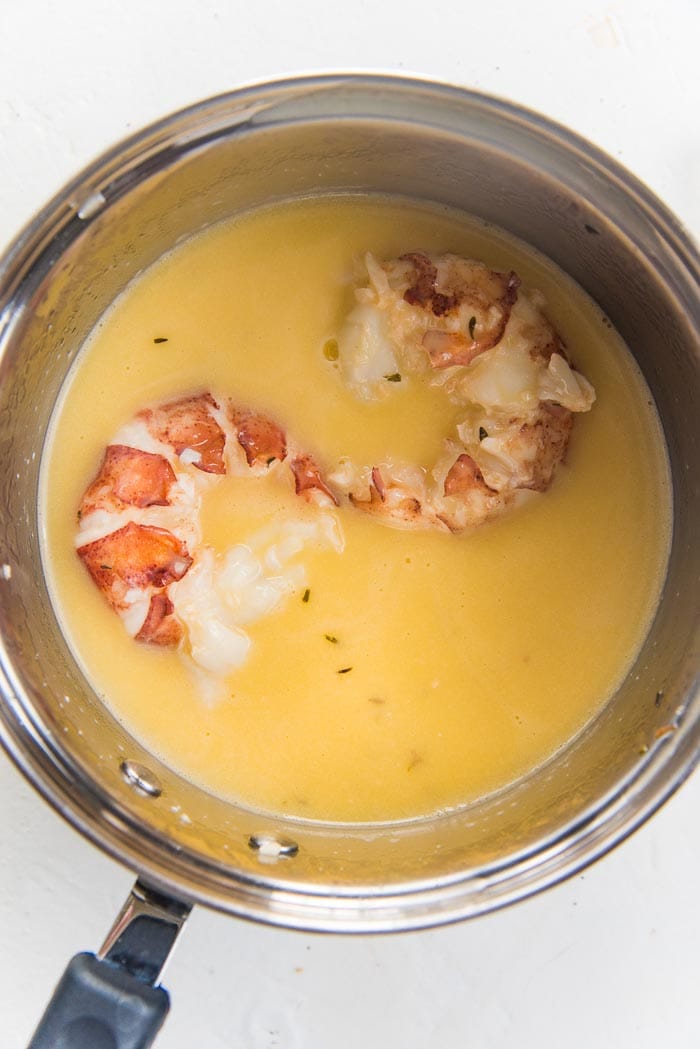
How to remove cooked lobster meat from the shell
Lobsters are built to play hard to get. No point knowing how to clean and cook lobster, if you can’t get to that sweet, buttery, delicious meat inside! So here’s how I get the lobster meat out of a whole lobster.
Once the lobster is cooked (I personally prefer steaming), let it cool down for a few minutes, either with cold water, an ice bath or at room temperature. Remember that the lobster keeps cooking after being steamed, so I prefer to shock it with ice to stop the cooking immediately to prevent over-cooking.
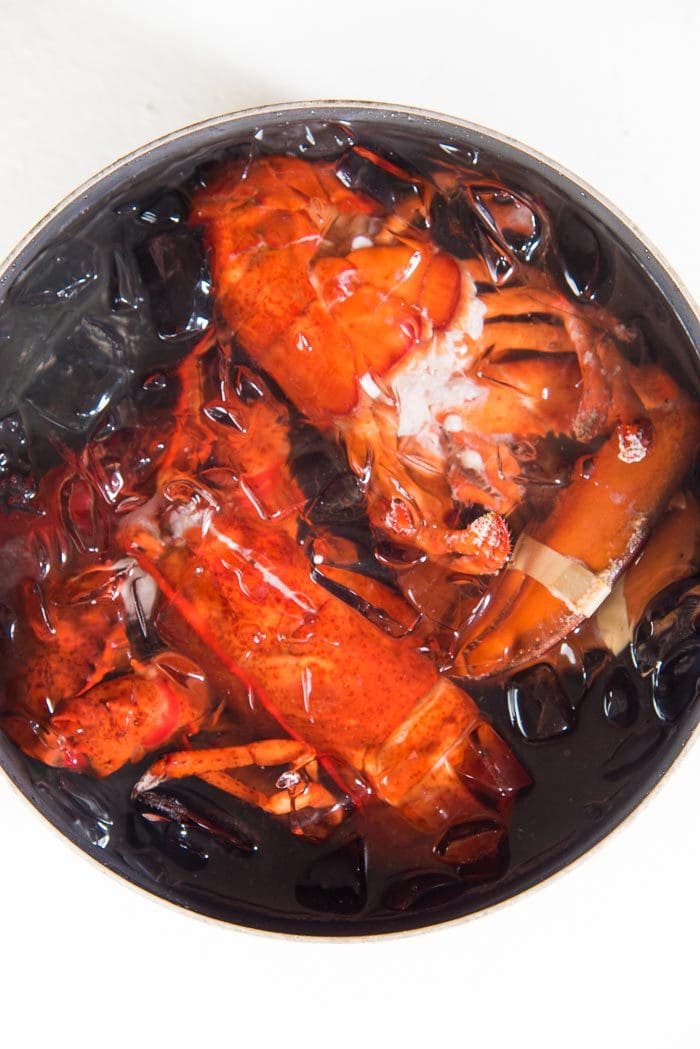
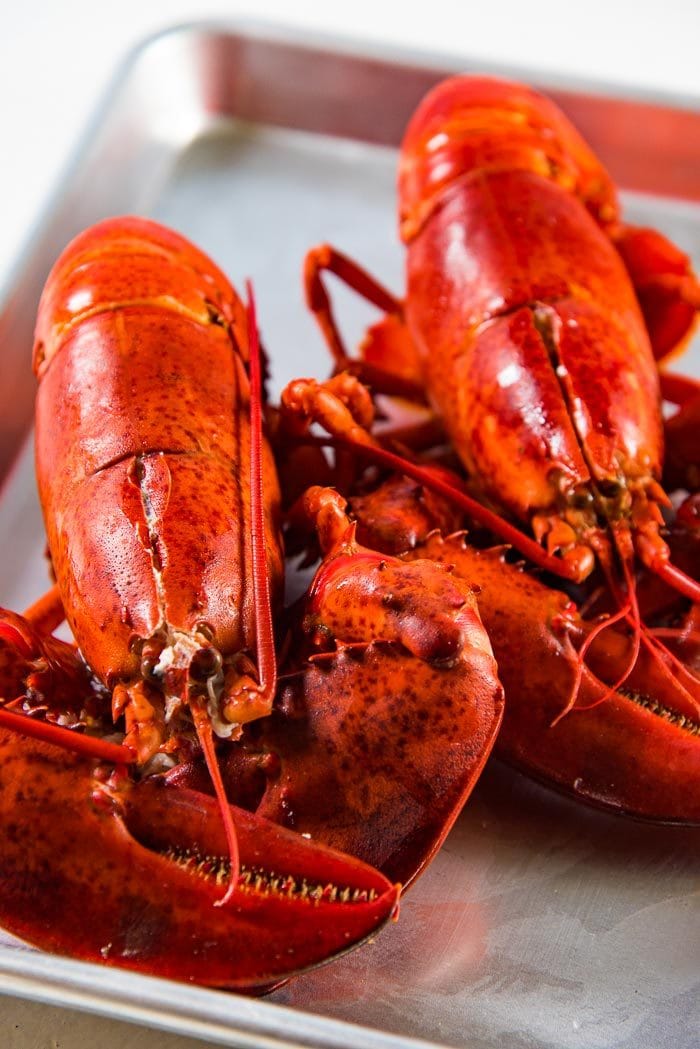
Then remove the claws and knuckles, as well as the legs. You’ll be removing the meat from the claws and knuckles as well, but I like to suck the meat out of the legs with some melted butter dipping sauce.
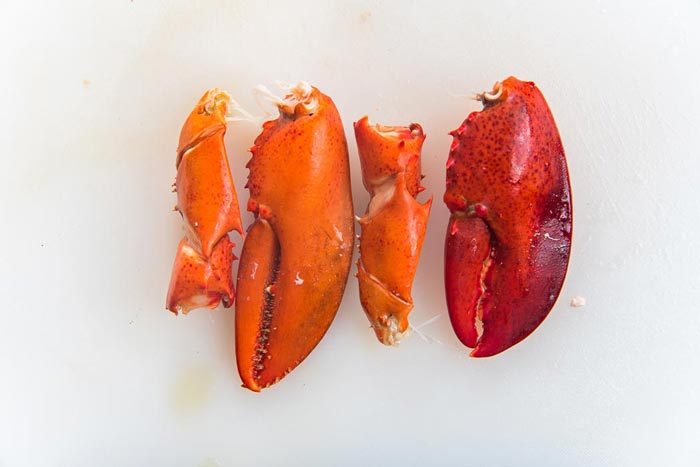
If I want to remove the claw meat in ONE PIECE, then first I gently loosen the smaller claw. There’s a little clear cartilage quill attached to this small claw, so try to locate it first and remove it. You will now have a small piece of lobster meat exposed (where the small claw previously was), and the rest in the big claw shell.
Use the blunt, back side of a heavy knife, OR lobster crackers to crack the large lobster claw. I prefer to crack it at the base, so I can gently pull the whole lump of meat out, in one big piece.
Alternatively, you can just crack the lobster claws and take out the meat. Then crack more of the shell as you go, to get all the meat out.
Crack the knuckles with a lobster cracker or the back of a heavy knife to remove the meat from the knuckles too.
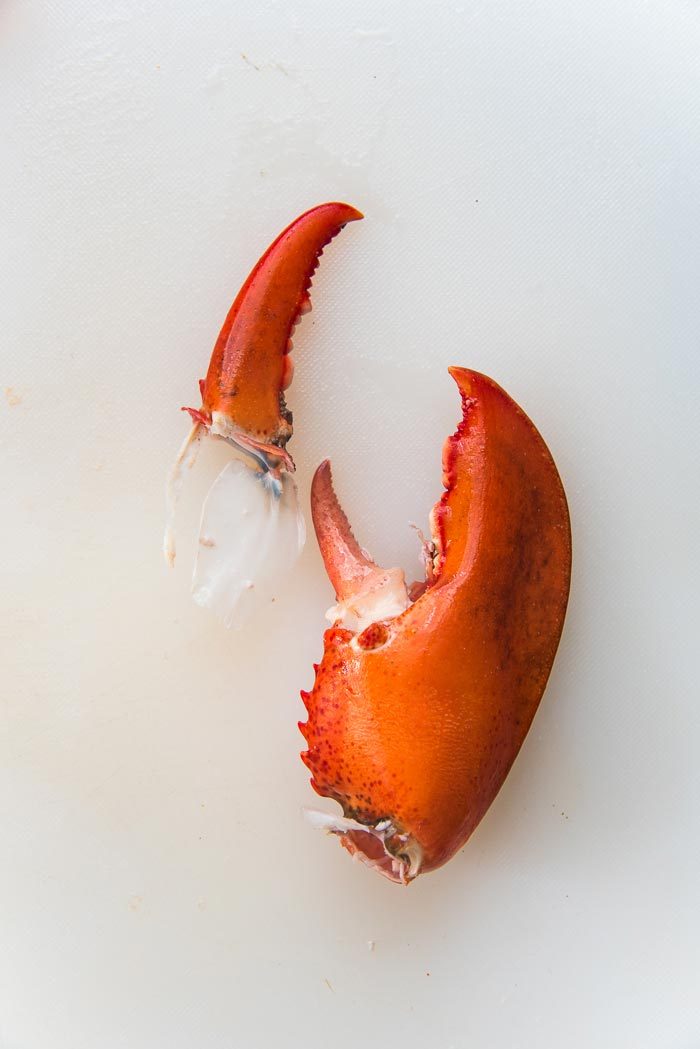
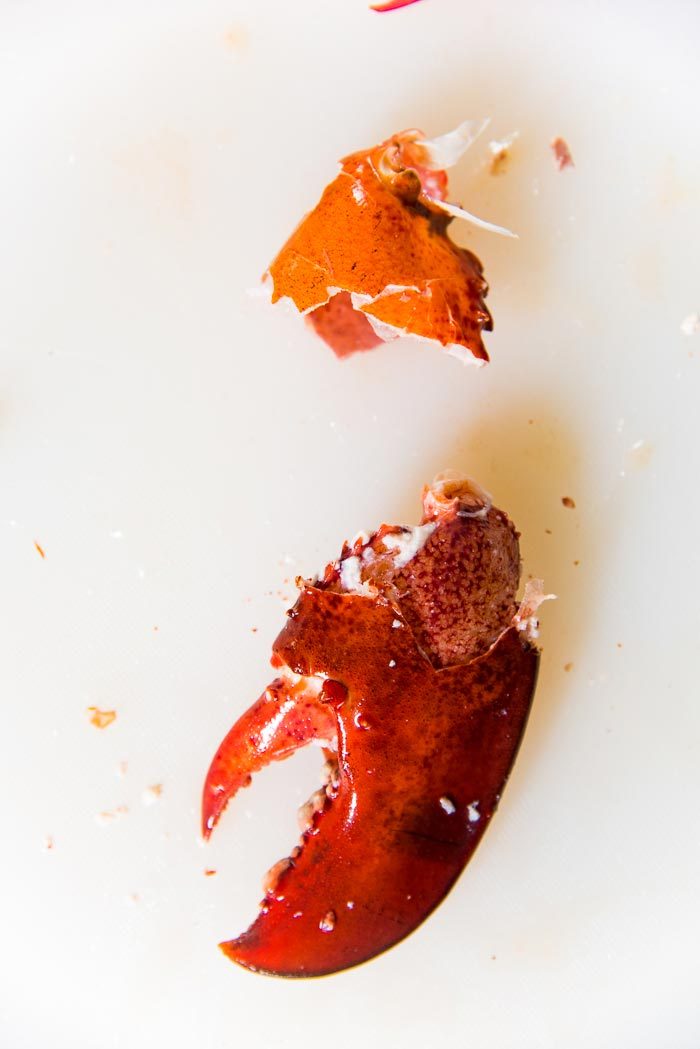
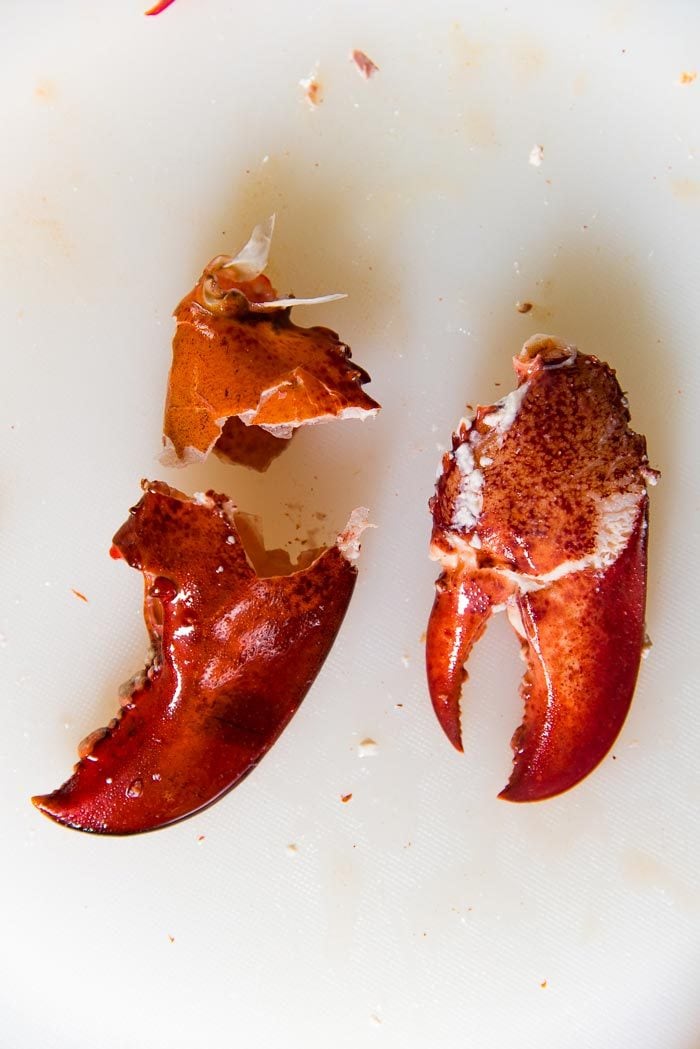
You can cut through the entire lobster (so you get two halves), and just remove the tail meat by peeling it out of the halved shell. But if you want to remove the tail whole (and not cut in half), then follow the steps below.
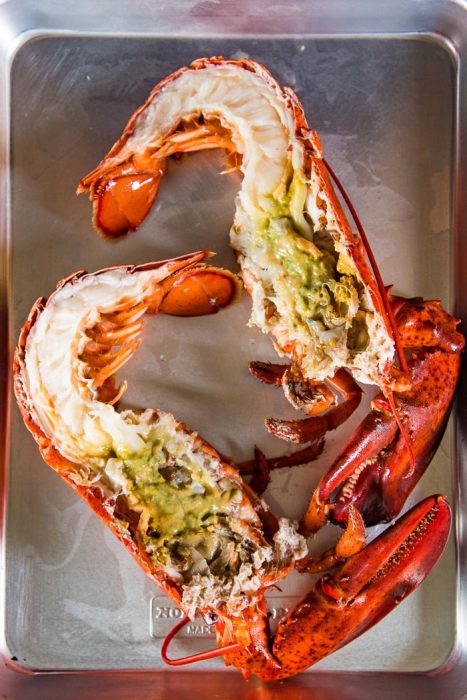
Grip the tail firmly in one hand and the carapace in the other. Twist the tail off from the carapace. Some of the tomalley (green stuff) or roe (black stuff, which would be pink/red if it’s fully cooked through) will get on the tail meat when you do this. Wash this off.
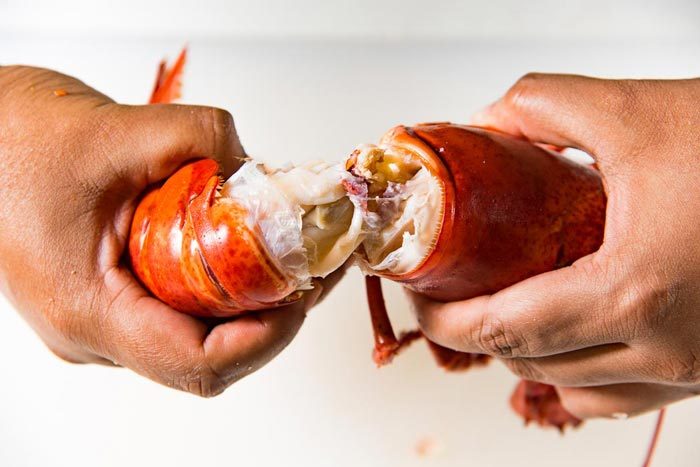
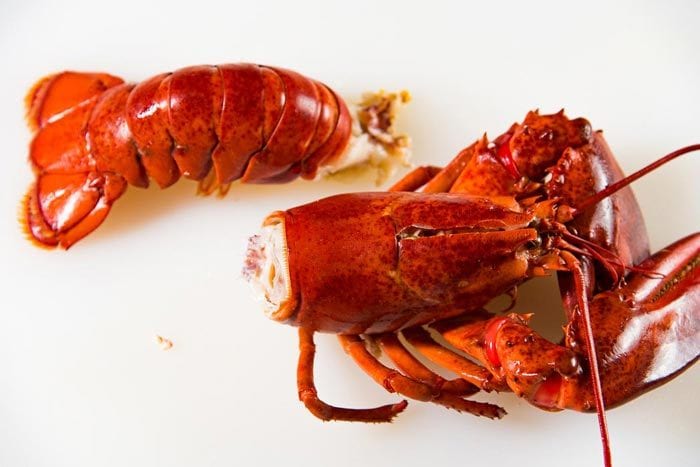
Then you can remove the meat from the lobster tail, in one of two ways.
- Place the tail in the palm of your hands, with the soft underside facing up. Then squeeze the lobster tail from the sides (as shown below), until you hear a crack. Next, pull apart the soft shell until you can get to the meat inside. You can use this method to crack the whole tail shell.
- If you’d like to keep the tail shell in good condition (for presentation or serving purposes), then cut the soft underside shell with kitchen shears – from the top all the way to the tip of the tail. Peel off the soft shell so that the meat is exposed. Gently remove the meat from the lobster shell. This way the red shell should still be intact, and you can stuff it with lobster meat that’s been tossed in a delicious sauce and serve it like that.
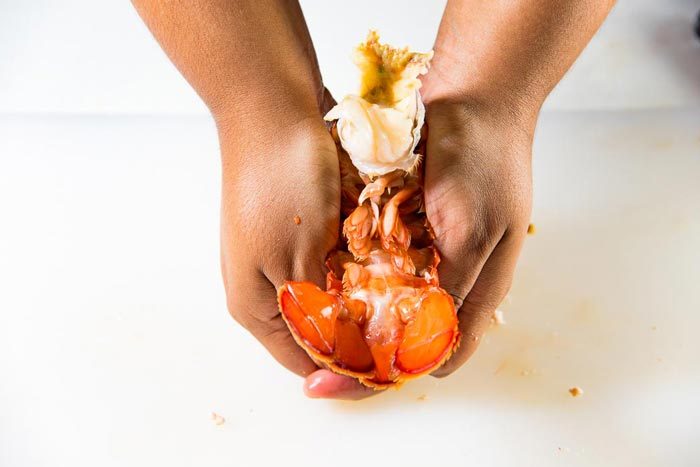
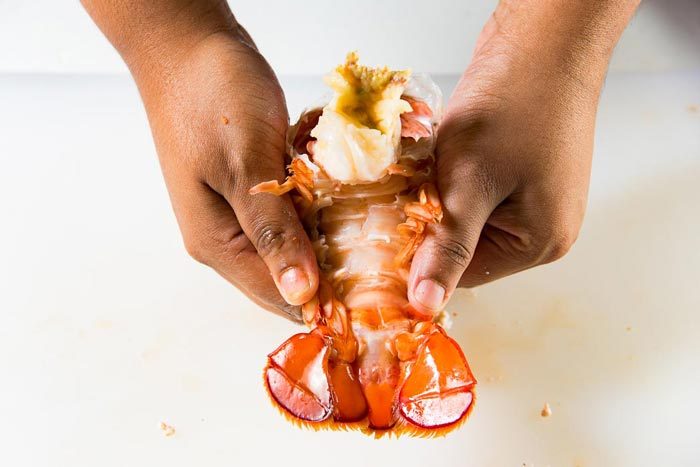
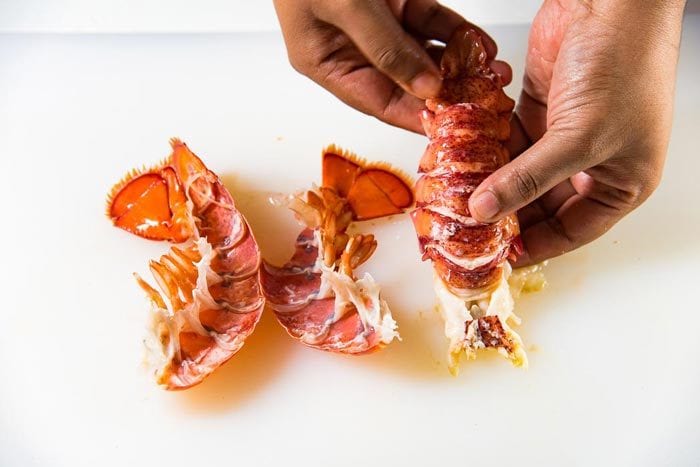
So there you have it! 🙂 Now that we had this lobstah talk, you know all about,
- How to choose the best lobster for cooking,
- What types of lobster you can find during different seasons,
- How to cook lobster, including
- How to boil lobster,
- How to steam lobster,
- How to grill lobster (or how to bbq or roast lobster)
- How to poach lobster in butter
- How to remove lobster meat from the shell, while making sure the meat is intact.
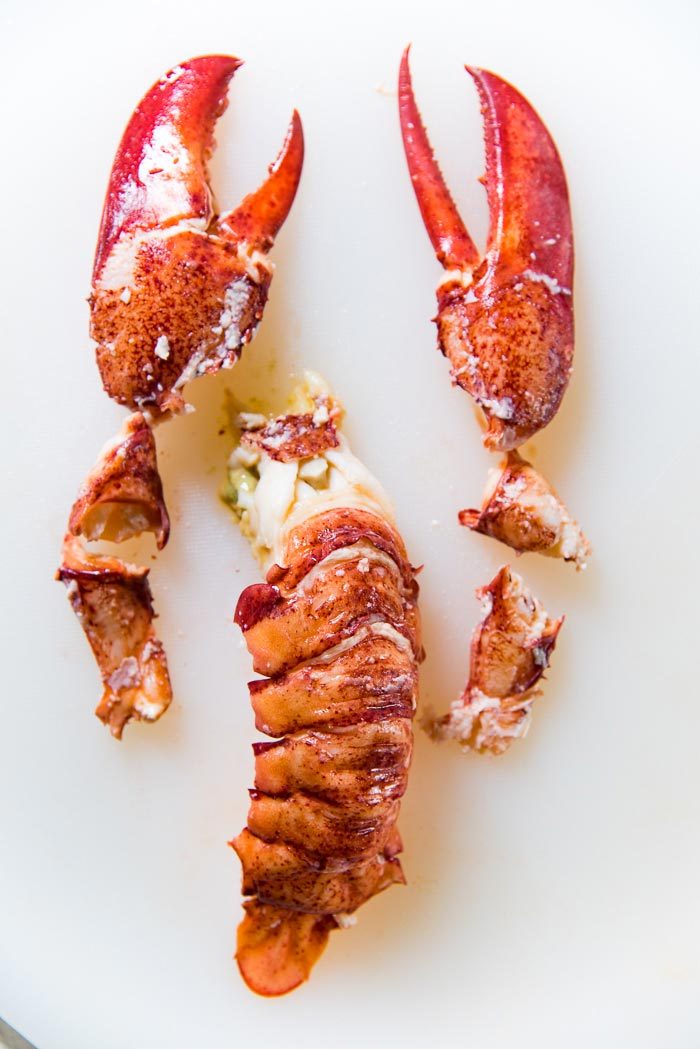
For a couple of delicious lobster recipes, check out these Maine lobster rolls and this simple but fancy butter lobster risotto!
If you liked this tutorial on how to cook lobster, don’t forget to subscribe for new (and free) recipes by entering your email address in the subscription box below the recipe card (and get all these recipes delivered straight to your inbox), so you don’t miss out on a thing. You can find me on FACEBOOK, INSTAGRAM, PINTEREST, and YOU TUBE.
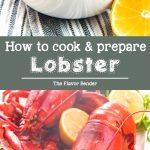
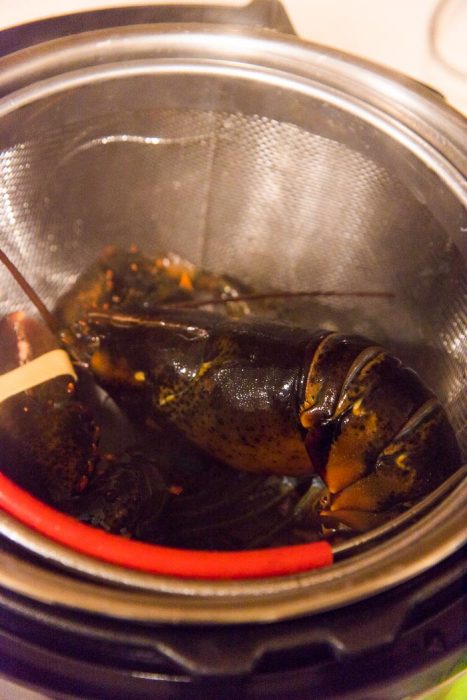
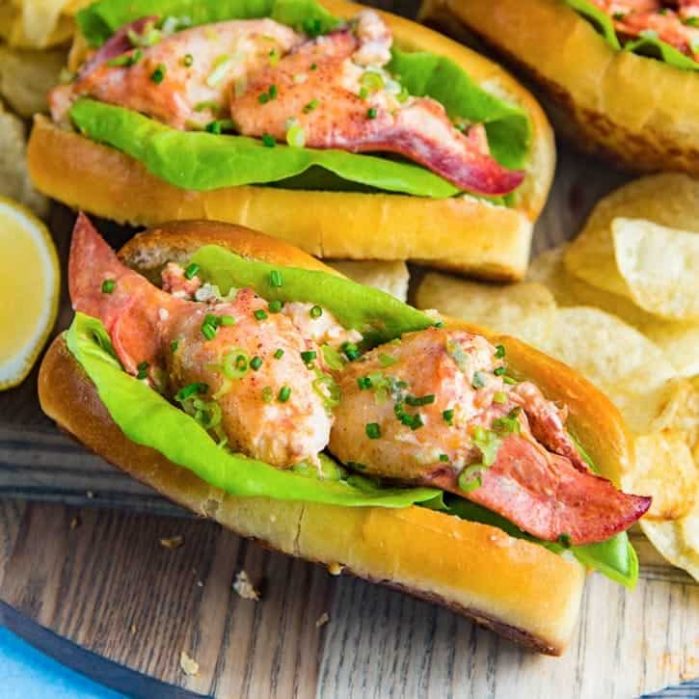
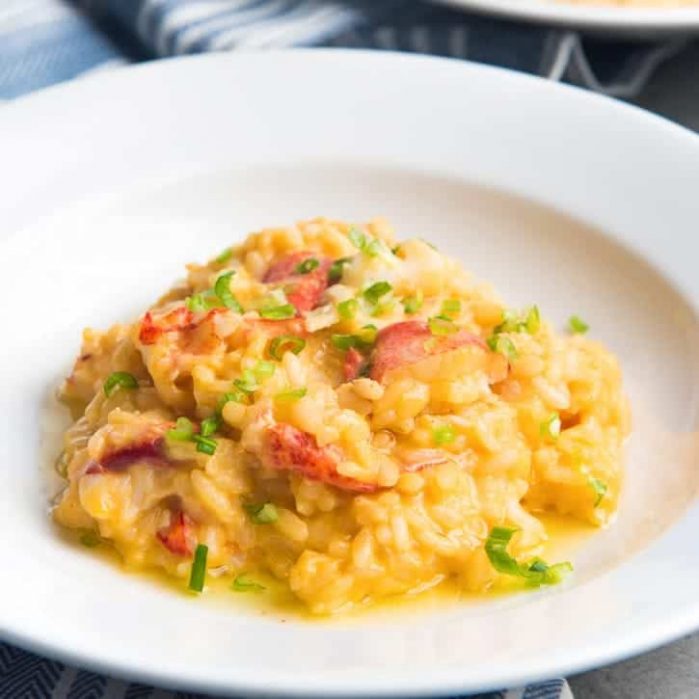
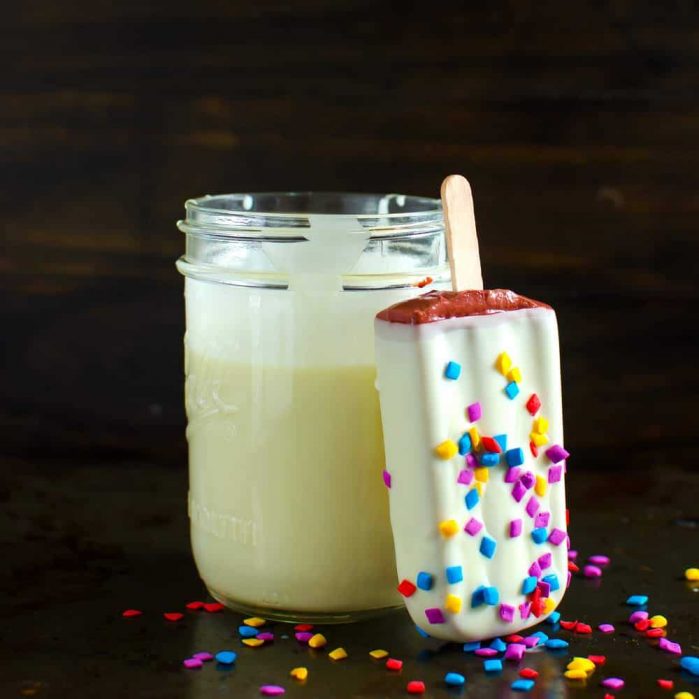
Tom redmond says
You have given the best read out on how to cook lobster well done &happy christmas
Janice Wells says
Great advice, except the tomally is considered a delicacy and females are coveted for the roe.
Bob Lauen says
I loved it
Rayne says
I hope you answer questions quickly. I have been looking everywhere for the answer to this question, com haven’t found it. I will be using a whole live lobster. If you want to serve your lobster tail whole but butterflied, do you butterfly the tail before or after boiling/steaming? What I want to do but I am not sure it’s able to be done is I want to cook the whole lobster by steaming, but I want to butterfly and broil the lobster tail before serving. What would be the correct way and in what order to do this?
Dini says
Hi Rayne
If the lobster tail is to be served butterflied, then it should be done prior to cooking. Usually butterflied lobster tails can be broiled with butter/ oil and other flavoring.
I haven’t cooked lobster whole, and THEN butterflied the tail. You could cook the butterflied tail separately, and the claws separately if you like. The body of the lobster doesn’t really have any meat at all, but is excellent for stock.
Hope that helps
Cecile king says
This is so cool
Keshis says
This was very helpful
G.Hussain bhatti says
Thanks i love this
George Fulton Bode says
I usually prepare Lobster Thermidor a la Bode’, Basically steaming vry quickly, undercook, jus to remove meat from shell after splitting lengthwise, 1.) Cube meat & mushrooms-bitesize, In pan melt butter, meat, mushrooms, finely chopped shallots, garlic, grn onion, celery, for roux. Mix Knorr’s Newburg sauce mix with some flour, make roux, add cup of HeavyCream, mixture shud look like UNPALATABLE MUCK !! Place back in shell/body, sprinkle top with bread crumb/parmesan mix & bake at 300° until a bit more than golden brown. Best dish U will have EVER TASTED
Gina palmes says
Wow love it
Irene Styles says
You are wrong in saying lobsters ( crustaceans) do not feel pain. They are sentient beings. I am pleased to hear that you do try and teach others, to kill first in a humane way before cooking.
Dini says
Hi Irene, thank you for your comment. You are probably right, or probably wrong. While there’s some suggestive behavioral evidence supporting the idea, there’s obviously no way to conclusively prove that lobsters feel pain. This is a matter of scientific debate. Either way, I don’t actually say that lobsters don’t feel pain. What I do say is that they evidently don’t perceive pain the same way we do, which given how different our nervous systems are, is just stating the obvious. But like you said, I personally prefer to exercise precaution, and advocate killing them first in a humane way before cooking.
Fiona Manoon says
I never tried cooking lobster at home before and after reading this amazing post, I feel like I have to give it a try!
Julie Menghini says
We love lobster but I wouldn’t know the first thing about taking them apart so usually just get the tail. I’ll be keeping this and look at your references to get a couple lobstahs for a special occasion!
sophia durkov says
I have lived on both coasts and really love lobster. Now I am stuck in Texas, not exactly lobster country, would like to know more about buying lobster from a tank, the Asian groceries have live lobster tanks, but I do not know how long they have been in there. Any more info would be appreciated.
Dini says
Hi Sophia,
I live in Missouri and understand your struggle! 🙂
If you’re choosing lobster from a tank, the same criteria that I described in the post apply. A good sign of hungry lobsters that have been kept in tanks for too long is short antennae, because they tend to eat each others’ antennae when hungry. So you want to look for lobster with long antennae. Plus, when the lobster is picked up, the tail should be quite lively. If they are very lethargic, that’s a sign of not being fresh as well. Lobsters are lively fresh out of sea water, and being sluggish and lethargic is an indication that they’re hungry or exposed to cold temperatures (like if you ship lobster overnight from a specialized lobster shipping company).
You also have the option of getting fresh lobster shipped to you overnight from different vendors online (which is what I do now, I use a Maine-based company and they ship overnight to me). They come in a cooler box with ice packs, so that the lobster is fresh and alive when it gets to you. But this is also the more expensive option.
I hope that helps!